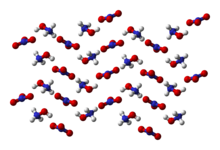
| |

| |
| Names | |
|---|---|
| Other names
hydroxylamine nitrate
| |
| Identifiers | |
3D model (JSmol)
|
|
| ChemSpider | |
| ECHA InfoCard | 100.033.342 |
| EC Number |
|
PubChem CID
|
|
CompTox Dashboard (EPA)
|
|
| |
| |
| Properties | |
| [NH3OH]+[NO3]− | |
| Molar mass | 96.04 g/mol |
| Density | 1.84 g/cm3 |
| Melting point | 48 °C |
| Soluble | |
| Hazards | |
| GHS labelling: | |
    
| |
| Danger | |
| H201, H302, H311, H315, H317, H319, H351, H373, H400 | |
| P201, P202, P210, P230, P240, P250, P260, P261, P264, P270, P272, P273, P280, P281, P301+P312, P302+P352, P305+P351+P338, P308+P313, P312, P314, P321, P322, P330, P332+P313, P333+P313, P337+P313, P361, P362, P363, P370+P380, P372, P373, P391, P401, P405, P501 | |
| Safety data sheet (SDS) | External MSDS (as 18 % solution) |
| Related compounds | |
Other anions
|
Hydroxylammonium sulfate Hydroxylammonium chloride |
Other cations
|
Ammonium nitrate |
Related compounds
|
Hydroxylamine |
Except where otherwise noted, data are given for materials in their standard state (at 25 °C [77 °F], 100 kPa).
| |
Hydroxylammonium nitrate or hydroxylamine nitrate (HAN) is an inorganic compound with the chemical formula [NH3OH]+[NO3]−. It is a salt derived from hydroxylamine and nitric acid. In its pure form, it is a colourless hygroscopic solid. It has potential to be used as a rocket propellant either as a solution in monopropellants or bipropellants.[1] Hydroxylammonium nitrate (HAN)-based propellants are a viable and effective solution for future green propellant-based missions, as it offers 50% higher performance for a given propellant tank compared to commercially used hydrazine.
- ^ Spores, Ronald A.; Masse, Robert; Kimbrel, Scott; McLean, Chris (15–17 July 2013). "GPIM AF-M315E Propulsion System" (PDF). San Jose, California, USA: 49th AIAA/ASME/SAE/ASEE Joint Propulsion Conference & Exhibit. Archived (PDF) from the original on 2014-02-28.